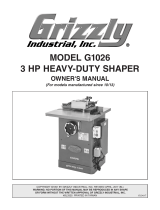
4
GENERAL SAFETY RULES
READ THE MANUAL: Always read the owner's
manual carefully before attempting to use the ma-
chine. Know the limitations and hazards associated
with its use.
INSTALLATION: If mounting machine to the floor,
use high quality anchor bolts through the mounting
holes on the base. If using a mobile base, be sure to
lock the wheels.
PROTECTION: Take every precaution to protect
yourself, others around you, and the machine itself,
from improper use.
GUARDS: Be sure machine guards are in place and
in good working order. Use them at all times on op-
erations where they can be used. If a guard must be
removed for any operation, make sure it is replaced
immediately following completion of that operation.
HOUSEKEEPING: Before turning on machine, re-
move all extra equipment such as keys, wrenches,
scrap, stock, and cleaning rags from the machine.
Keep the area around machine clean and free of
scrap material and sawdust to mimimize the danger
of slipping.
ELECTRICAL GROUNDING: Your machine must
be electrically grounded. If a cord and plug are
used, make certain the grounding lug connects to a
suitable ground. Follow the grounding procedure
indicated by the National Electric Code. Keep
power tools in dry areas free from moisture.
TOOL MAINTENANCE: Clean and sharp tools
give better and safer performance. Dull tools can
cause kickback and excessive chatter. Before
making a cut, always check the condition and
adjustment of the tools. Never use a tool that is
not balanced and rated for the selected RPM.
POWER OFF: Make sure the machine is either un-
plugged or electrically disconnected and locked out
when performing maintenance, chaning cutters, or
service work.
CHECK DAMAGED PARTS: Check for alignment
of moving parts, binding of moving parts, breakage
of parts, mounting, and any other condition that
may affect the machine's operation. A guard or
other part that is damaged should be properly
repaired or replaced.
DO NOT USE IN DANGEROUS ENVIRONMENT:
Do not use power tools in damp or wet locations,
or expose them to rain. Keep work area well
lighted.
DRESS CODE: Do not wear loose clothing, neck-
ties, jewelry, or gloves that can get caught in moving
parts. Confine long hair. Keep sleeves above the
elbow.
EYES: Always wear approved safety goggles,
glasses, or a face shield when operating this
machine. There are no exceptions to this rule.
Every day eyeglasses only have impact resistant
lenses, they ARE NOT safety glasses.
DO NOT OVERREACH: Maintain a balanced
stance and keep your body under control at all
times. Do not overreach or use excessive force to
perform any operation.
IF YOU ARE NOT thoroughly familiar with the op-
eration of shapers, obtain advice from your supervi-
sor, instructor or other qualified person.
DRUGS, ALCOHOL, MEDICATION: Do not oper-
ate tool while under the influence of drugs, alcohol,
or any medication.
Health Hazards. Some dust created by power
sanding, sawing, grinding, drilling and other
construction activities contains chemicals known to
cause cancer, birth defects or other reproductive
harm. Some examples of these chemicals are:
* Lead from lead-based paint.
* Crystalline silica from bricks and cement and
other masonry products.
* Arsenic and chromium from chemically-treated
lumber.
Your risk from these exposures varies, depending
on how often you do this type of work. To reduce
your exposure to these chemicals, work in a well-
ventilated area, and work with approved safety
equipment, such as those dust masks that are
specifically designed to filter out microscopic
particles.
SPECIFIC SAFETY RULES
SHORT STOCK: Never shape stock less than 12
inches in length without special fixtures Where
practical, shape longer stock and cut to size.
12 INCH RULE: When shaping, never allow your
hands to come closer than 12 inches to the cutters.
HAND SAFETY: Never pass the hands directly
over or in front of the cutters. As one hand ap-
proaches the 12 inch radius point, remove it (or the
push stick) in an arc motion and reposition hands
12 inches beyond the cutters, Figure 1.
!
!





















